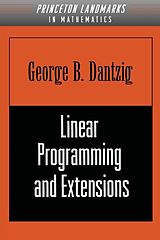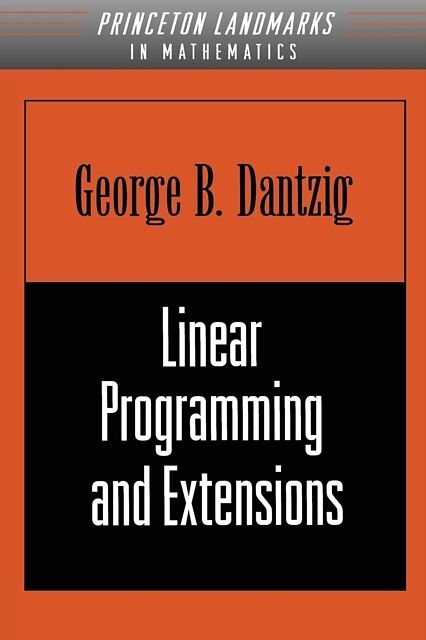Linear Programming and Extensions
Einband:
Kartonierter Einband
EAN:
9780691059136
Untertitel:
Englisch
Genre:
Programmiersprachen
Autor:
George Dantzig
Herausgeber:
Princeton University Press
Anzahl Seiten:
650
Erscheinungsdatum:
23.08.1998
ISBN:
0691059136
"The author of this book was the main force in establishing a new mathematical discipline, and he has contributed to its further development at every stage and from every angle. This volume ... is a treasure trove for those who work in this fieldteachers, students, and users alike. Its encyclopaedic coverage, due in part to collaboration with other experts, makes it an absolute must."S. Vajda, Zentralblatt für Mathematik und ihre Grenzgebiete
Autorentext
George B. Dantzig (1914–2005) is widely acclaimed as the father of linear programming and was a leading figure in the development of mathematical optimization, making important contributions to fields such as industrial engineering, economics, and statistics. He was professor emeritus of operations research and computer science at Stanford University.
Klappentext
In real-world problems related to finance, business, and management, mathematicians and economists frequently encounter optimization problems. In this classic book, George Dantzig looks at a wealth of examples and develops linear programming methods for their solutions. He begins by introducing the basic theory of linear inequalities and describes the powerful simplex method used to solve them. Treatments of the price concept, the transportation problem, and matrix methods are also given, and key mathematical concepts such as the properties of convex sets and linear vector spaces are covered. George Dantzig is properly acclaimed as the "father of linear programming." Linear programming is a mathematical technique used to optimize a situation. It can be used to minimize traffic congestion or to maximize the scheduling of airline flights. He formulated its basic theoretical model and discovered its underlying computational algorithm, the "simplex method," in a pathbreaking memorandum published by the United States Air Force in early 1948. Linear Programming and Extensions provides an extraordinary account of the subsequent development of his subject, including research in mathematical theory, computation, economic analysis, and applications to industrial problems. Dantzig first achieved success as a statistics graduate student at the University of California, Berkeley. One day he arrived for a class after it had begun, and assumed the two problems on the board were assigned for homework. When he handed in the solutions, he apologized to his professor, Jerzy Neyman, for their being late but explained that he had found the problems harder than usual. About six weeks later, Neyman excitedly told Dantzig, "I've just written an introduction to one of your papers. Read it so I can send it out right away for publication." Dantzig had no idea what he was talking about. He later learned that the "homework" problems had in fact been two famous unsolved problems in statistics.
Zusammenfassung
The influential book that established the mathematical discipline of linear programming
In the worlds of finance, business, and management, mathematicians and economists frequently encounter problems of optimization. In this classic book, George Dantzig shows how the methods of linear programming can provide solutions. Drawing on a wealth of examples, he introduces the basic theory of linear inequalities and describes the powerful simplex method used to solve them. He discusses the price concept, the transportation problem, and matrix methods, and covers key mathematical concepts such as the properties of convex sets and linear vector spaces. Dantzig demonstrates how linear programming can be applied to a host of optimization problems, from minimizing traffic congestion to maximizing the scheduling of airline flights.
An invaluable resource for students and practitioners alike, Linear Programming and Extensions is an extraordinary account of the development and uses of this versatile mathematical technique, blending foundational research in mathematical theory with computation, economic analysis, and applications to industrial problems.
Inhalt
PrefaceCh. 1The Linear Programming ConceptCh. 2Origins and InfluencesCh. 3Formulating a Linear Programming ModelCh. 4Linear Equation and Inequality SystemsCh. 5The Simplex MethodCh. 6Proof of the Simplex Algorithm and the Duality TheoremCh. 7The Geometry of Linear ProgramsCh. 8Pivoting, Vector Spaces, Matrices, and InversesCh. 9The Simplex Method Using MultipliersCh. 10Finiteness of the Simplex Method Under PerturbationCh. 11Variants of the Simplex AlgorithmCh. 12The Price Concept in Linear ProgrammingCh. 13Games and Linear ProgramsCh. 14The Classical Transportation ProblemCh. 15Optimal Assignment and Other Distribution ProblemsCh. 16The Transshipment ProblemCh. 17Networks and the Transshipment ProblemCh. 18Variables with Upper BoundsCh. 19Maximal Flows in NetworksCh. 20The Primal-Dual Method for Transportation ProblemsCh. 21The Weighted Distribution ProblemCh. 22Programs with Variable CoefficientsCh. 23A Decomposition Principle for Linear ProgramsCh. 24Convex ProgrammingCh. 25UncertaintyCh. 26Discrete Variable Extremum ProblemsCh. 27Stigler's Nutrition Model: An Example of Formulation and SolutionCh. 28The Allocation of Aircraft to Routes Under Uncertain DemandBibliographyIndex

Leider konnten wir für diesen Artikel keine Preise ermitteln ...
billigbuch.ch sucht jetzt für Sie die besten Angebote ...
Die aktuellen Verkaufspreise von 5 Onlineshops werden in Realtime abgefragt.
Sie können das gewünschte Produkt anschliessend direkt beim Anbieter Ihrer Wahl bestellen.
Loading...
Die aktuellen Verkaufspreise von 5 Onlineshops werden in Realtime abgefragt.
Sie können das gewünschte Produkt anschliessend direkt beim Anbieter Ihrer Wahl bestellen.
| # | Onlineshop | Preis CHF | Versand CHF | Total CHF | ||
|---|---|---|---|---|---|---|
| 1 | Seller | 0.00 | 0.00 | 0.00 |
